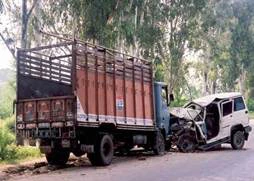 As a researcher in vehicle safety, my friends in the US often ask, “Which is the safest car to buy?” My friends and family back in India, on the other hand, have never connected with that question. Cars sell for brand-name, comfort and fuel economy, not for the way they perform in a crash. Technological progress and reforms in compliance standards in high-income countries have, however, demonstrated that vehicle safety can prevent many crash-related deaths. Ambitious as it may sound, safety pioneers Volvo aspire to launch a “no-death car” by 2020; showcasing one company’s commitment to this cause.
As a researcher in vehicle safety, my friends in the US often ask, “Which is the safest car to buy?” My friends and family back in India, on the other hand, have never connected with that question. Cars sell for brand-name, comfort and fuel economy, not for the way they perform in a crash. Technological progress and reforms in compliance standards in high-income countries have, however, demonstrated that vehicle safety can prevent many crash-related deaths. Ambitious as it may sound, safety pioneers Volvo aspire to launch a “no-death car” by 2020; showcasing one company’s commitment to this cause.
Improvements in vehicle safety (i.e. safety of the driver and passengers inside a car, as opposed to that of pedestrians and other road users) are an essential component of the overall road safety agenda: 475,000 vehicle occupants die every year in traffic crashes, accounting for a third of all road death victims. Given that 90% of road deaths happen in low- and middle-income countries, it is appropriate and timely to discuss how these countries can ensure standard vehicle safety features for their fleet and reap benefits similar to high-income countries.
Recognition of vehicle safety’s role in reducing global road deaths
In 2004, the World Report on Road Traffic Injury Prevention, jointly produced by the World Bank and the WHO, recognized the importance of vehicle safety and crashworthiness in reducing global road deaths. Following on its recommendations, the UN Decade of Action for Road Safety, 2011-2020, specifically calls for country-wide legislative measures and standardized compliance tests in vehicle safety. In support, consumer-oriented programs on vehicle crash safety (like the Global New Car Assessment Program and its regional equivalents in developing countries: Latin NCAP, China NCAP and the ASEAN NCAP) have successfully raised public awareness and encouraged the automotive industry to develop affordable and universal safety standards across the world. National-level vehicle safety legislation in most countries, however, remains either non-existent or non-compliant with global standards such as the UN World Forum for Harmonization of Vehicle Regulations.
Vehicle safety behind other priorities in developing economies
Policymakers in developing countries tend to overlook the issue of vehicle safety. First, it is considered to have less impact on saving lives than other road safety interventions. Now, although “only” 33% of road crash victims in developing countries die inside a vehicle, one must take into account the current trends of rapid motorization and highway expansion in these countries. For instance, China alone accounts for 60% of the increase in global car sales in the past decade. Road users in these countries will continue to travel more, at faster speeds, and mostly using personal cars – all indicative of the increasing relevance of vehicle safety.
Another factor that leads decision-makers to overlook vehicle safety is a perception that brand-name new cars are sufficiently safe in all countries. Unfortunately, the evidence suggests otherwise. Latin NCAP crash-test results found new cars sold in that region were 20 years behind in technology when compared to similarly priced US and European counterpart models built by the same company. The reasons included compromised structural integrity of the car and skipping standard safety features like airbags to make cars more affordable. This problem is not limited to cars: freight and public transport vehicles also suffer from poor maintenance and non-compliance with crashworthiness standards.
In developing countries, vehicle safety has to compete with other transport priorities such as reducing environmental impact and urban congestion. Tomorrow’s emerging market will favor cars that are smaller, lighter and yet powerful. These characteristics need not compromise the cars’ safety performance, but they do make a convincing case to ensure safety compliance as the next generation of vehicles rolls out on the high-speed roadways.
Role for development organizations
Development organizations, which are already deeply engaged in road safety, have a pivotal role to play in promoting the vehicle safety agenda by promoting awareness of minimum vehicle safety standards and building in-country capacity to ensure compliance. This will entail more collaboration with the private sector (insurance, auto industry), NGOs, and government agencies to provide incentives for change. Given the slow pace of legislative change, liaising with regional NCAP programs or developing local crash investigation programs may be a good way to spearhead this effort. Like other road safety interventions, this too is a multi-sectorial capacity building challenge requiring commitment and coordination from all stakeholders.
The bottom line here is that, although its potential has been largely neglected in developing countries, improved vehicle safety is one of the easier gains to be achieved in road safety – and can help prevent millions of unnecessary deaths. But road users will only be able to reap the benefits of safer vehicles if all stakeholders do their part, including development organizations.
Photo credit: Vani Viswanathan


Join the Conversation